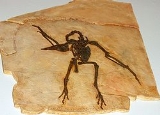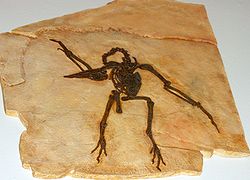
Pseudocrypturus
Encyclopedia
Pseudocrypturus is a genus
of extinct paleognathous
bird. One species is known, Pseudocrypturus cercanaxius. It is a relative of such modern birds as ostrich
es. It lived in the early Eocene
.
 The holotype
The holotype
fossil is in the collection of the Smithsonian's National Museum of Natural History
. It has catalog number USNM 336103. It was collected from the Fossil Butte Member, Green River Formation
, Lincoln County, Wyoming, USA.
. The species name cercanaxius comes from ancient Greek words kerkion, tail, and anaxios, worthless, in reference to the rudientary pygostyle
of this species.
Genus
In biology, a genus is a low-level taxonomic rank used in the biological classification of living and fossil organisms, which is an example of definition by genus and differentia...
of extinct paleognathous
Paleognathae
The Palaeognathae or paleognaths are one of the two living superorders of birds. The other living superorder is Neognathae. Together these two clades form the subclass Neornithes....
bird. One species is known, Pseudocrypturus cercanaxius. It is a relative of such modern birds as ostrich
Ostrich
The Ostrich is one or two species of large flightless birds native to Africa, the only living member of the genus Struthio. Some analyses indicate that the Somali Ostrich may be better considered a full species apart from the Common Ostrich, but most taxonomists consider it to be a...
es. It lived in the early Eocene
Eocene
The Eocene Epoch, lasting from about 56 to 34 million years ago , is a major division of the geologic timescale and the second epoch of the Paleogene Period in the Cenozoic Era. The Eocene spans the time from the end of the Palaeocene Epoch to the beginning of the Oligocene Epoch. The start of the...
.

Holotype
A holotype is a single physical example of an organism, known to have been used when the species was formally described. It is either the single such physical example or one of several such, but explicitly designated as the holotype...
fossil is in the collection of the Smithsonian's National Museum of Natural History
National Museum of Natural History
The National Museum of Natural History is a natural history museum administered by the Smithsonian Institution, located on the National Mall in Washington, D.C., United States. Admission is free and the museum is open 364 days a year....
. It has catalog number USNM 336103. It was collected from the Fossil Butte Member, Green River Formation
Green River Formation
The Green River Formation is an Eocene geologic formation that records the sedimentation in a group of intermountain lakes. The sediments are deposited in very fine layers, a dark layer during the growing season and a light-hue inorganic layer in winter. Each pair of layers is called a varve and...
, Lincoln County, Wyoming, USA.
Etymology
Pseudocrypturus means false tinamouTinamou
The tinamous are a family comprising 47 species of birds found in Central and South America. One of the most ancient living groups of bird, they are related to the ratites. Generally ground dwelling, they are found in a range of habitats....
. The species name cercanaxius comes from ancient Greek words kerkion, tail, and anaxios, worthless, in reference to the rudientary pygostyle
Pygostyle
Pygostyle refers to a number of the final few caudal vertebrae fused into a single ossification, supporting the tail feathers and musculature. In modern birds, the rectrices attach to these....
of this species.

